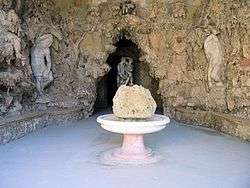Bernardo Buontalenti
Bernardo Buontalenti (Italian pronunciation: [berˈnardo ˌbwɔntaˈlɛnti]), byname of Bernardo Delle Girandole (c. 1531 – June 1608), was an Italian stage designer, architect, theatrical designer, military engineer and artist.

Biography
Buontalenti was born in Florence.
He entered the service of the Medici as a youth and remained with them the rest of his life. He is said to have been instructed in painting by Salviati and Bronzino, in sculpture by Michelangelo Buonarroti, in architecture by Giorgio Vasari, and to have learned miniature painting under Giulio Clovio. He executed a number of miniatures for Francesco, the son of Cosimo I. More than a painter, he was celebrated as an architect; in this role he was much employed in the design of fortifications, villas, and gardens and is considered one of the most important architects of the Mannerist period. He was also a great mechanic, and an excellent mathematician. In 1562 he travelled to Spain.
His first known work is from 1568, the Palazzo di Bianca Cappello in Florence. His main achievements include the project for the new city of Livorno, the decoration of Palazzo Pitti and the Boboli Gardens with the famous grotto, as well as the Parco di Pratolino of which little remains today, except for a giant sculpture by Giambologna, representing the Colossus of the Apennines. Buontalenti's skills as a military engineer are shown by the fortifications of the port of Livorno, the Forte di Belvedere in Florence, the city walls of Pistoia, Grosseto, Prato, Portoferraio (Elba) and Naples; he also perfected designs for cannons, and devised a new type of incendiary grenade.
In the Uffizi Palace of Florence, he built a great court stage, where, during the winter of 1585–1586, splendid festivities were produced under his direction. He designed costumes for the Medici extravaganzas. He was also an innovator in ice conservation and is credited with inventing the precursor to modern Florentine cream.[1]
Despite his successes, his prodigality led Buontalenti to financial ruin; he survived in his later life thanks to a pension given him by the Grand Duke of Tuscany.
Work
One of the theaters that Bernardo had built was the Theater of Baldracca (or Of The Dogana). It was one of the oldest theaters in Florence. It was open since 1576. At the time Bernardo was the Court Architect. The Theater, however is not like every other modern theater. In the Theater Of Baldracca the Stage would be raised a little and, the audience had to stand or sit on long benches to watch the live performance. Bernardo also included a box, with grates, that would seat very high ranked viewers. The grates allowed the viewers to see but to not be seen. However, the theater was not very popular and was replaced by the Uffizi Gallery Library.[2][3][4]
Another theatre Bernardo built was the Medici Theatre He had built it for the Grand Duke Francesco I Medici. He worked at the theatre between 1576 and 1586. He had worked on a mannerist and experimental architectural language for this theatre. In 1589 Bernardo had to modify the decorations to represent the authority of the Grand Duke Ferdinando I. The room structure was inspired by classical antiquity theatres. Bernardo also included a sloped floor that allowed the audience to see better. However, when the court moved to another person the room was left behind.
Buontalenti was involved in other Baroque theaters, but he could not continue due to his death. He did, however, help design stage machinery for specific performances. He also designed many allegorical costumes for the Medici Theatre. Last but not least, he arranged firework displays for spectacular performances.
References
- David, Elizabeth (2011-01-20). Harvest of the Cold Months: The Social History of Ice and Ices. Faber & Faber. ISBN 9780571275328.
- "Bernardo Buontalenti - Italian stage designer". Encyclopedia Britannica.
- "Performances at the Uffizi: the history of the Medici Theatre". Virtual Uffizi Gallery.
- "The theater of Baldracca, now Uffizi Gallery Library". Virtual Uffizi Gallery.
| Wikimedia Commons has media related to Bernardo Buontalenti. |
- Bryan, Michael (1886). Robert Edmund Graves (ed.). Dictionary of Painters and Engravers, Biographical and Critical (Volume I: A-K). York St. #4, Covent Garden, London; Original from Fogg Library, Digitized May 18, 2007: George Bell and Sons.CS1 maint: location (link)
- Bernardo Buontalenti and the Grotta Grande of Boboli, Florence: Maschietto Editore, 2012. ISBN 978-88-6394-041-1